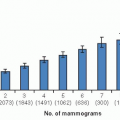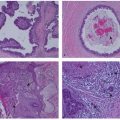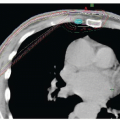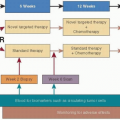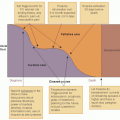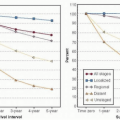Nursing Care in Patient Management and Quality of Life
Karen Meneses
Deborah K. Walker
Nurses have an integral role in the interdisciplinary management of patients from prevention, screening, and early detection through diagnosis, treatment, recurrence, and survivorship. This chapter is divided into patient care management along the cancer continuum with specific focus on patient management during the various therapeutic approaches to care. Each section emphasizes patient management related to education, symptom management, and psychosocial support.
PREVENTION, SCREENING, AND EARLY DETECTION
Prevention, screening, and early detection are important strategies in reducing the breast cancer incidence, particularly in high-risk women. The emphasis on lifestyle interventions along with routine screening has led to significant improvement in early detection of breast cancer.
Prevention
There are many risk factors for the development of breast cancer in women, but few can be modified. Table 87-1 lists risk factors. Lifestyle modifications are one area where nurses can be proactive and educate on strategies for risk reduction. Encouraging healthy nutrition, increased physical activity, weight management, and limited alcohol consumption are interventions that can reduce a women’s risk of breast cancer (1, 2 and 3). Although diet has not specifically been linked with an increased risk of breast cancer, obesity and weight gain have demonstrated an increased risk among postmenopausal women (4). Maintaining a healthy body mass index (BMI) through eating healthy and physical activity is important, not only for positive effects on body weight, but also for better psychological and quality-of-life outcomes (5). History of alcohol consumption is important to assess. As little as one drink per day of alcohol has been associated with an increased risk of breast cancer (6). Nurses involved in screening and early detection activities can educate on the risk of excess alcohol consumption, and recommend less than one drink per day (7).
Other prevention strategies for moderate- to high-risk women (i.e., BRCA1 and BRCA2) include risk reduction surgery or using a selective estrogen receptor (ER) modulator such as tamoxifen. Risk reduction surgery may include a bilateral mastectomy and/or bilateral salpingo-oophorectomy. Surgery is usually recommended in women with either the BRCA1 and BRCA2 mutation or in women at high risk (8). Surgery may have a negative impact psychologically, so counseling is vital prior to the procedure. Counseling should include the risk and benefits of surgery and discussion of other options, if available (i.e., reconstruction).
In women 35 years or older, tamoxifen has be used to decrease the risk of a second primary contralateral breast cancer (9). Nurses can educate women about the benefits of tamoxifen that include reducing the risk of invasive and noninvasive breast cancer, and reducing risk of a new primary contralateral breast cancer (9). Symptom management education while on tamoxifen is also important, and should include hot flash management, risk of thromboembolic events, and increased risk for endometrial cancer (9).
TABLE 87-1 Risk Factors | ||||||||||||||||||||||||||||||
|---|---|---|---|---|---|---|---|---|---|---|---|---|---|---|---|---|---|---|---|---|---|---|---|---|---|---|---|---|---|---|
| ||||||||||||||||||||||||||||||
Educating women about risk factors is ideally done by the health care team. Patients often turn to their nurses for information. Nurses can share information about modifiable and nonmodifiable risk factors (i.e., age, family history, etc.). This knowledge would help nurses identify those at risk for breast cancer and provide help when they counsel about prevention strategies.
When addressing risk factors and prevention strategies with women, there is the potential for psychological concerns. Women may overinterpret their risk with resultant increase in anxiety or stress which may lead to ignoring symptoms or recommendations for screening. Alternatively, women may see improvement in overall health when they follow the recommendations for lifestyle modification and screening for breast cancer.
Screening and Early Detection
Recommendations for breast cancer screening vary slightly depending on the recommended guidelines that are followed. The general consensus among all recommendations is that not one screening modality should be used alone. Breast self-awareness, clinical breast exam, and mammography should be used together, along with clinical reasoning to screen individuals for breast cancer (7, 10, 11 and 12). Nurses should be familiar with the recommendations supported by their institution and educate women accordingly.
Breast biopsy is performed when an area of suspicion has been identified on diagnostic evaluation. Fine-needle aspiration, core needle, and excisional biopsy are commonly used methods (7). Patients should be educated about the specific method, recovery period, and when follow-up occurs. Fineneedle aspirations are typically done when there is a low suspicion for malignancy. It is the least invasive and can be performed in the office using a needle and syringe to aspirate contents of the mass. Recovery is quick and patient usually does not have any limitations. If the result is benign, follow-up occurs within a few months to monitor for reaccumulation of fluid.
Core needle biopsies are done more frequently to obtain large tissue samples for analysis. After local anesthetic, a large-gauge hollow needle is inserted into the suspicious area and several samples are obtained. During the sampling process a “clicking” sound may occur as the sample is retrieved. The patient may feel pressure during the procedure, but not major pain. Bruising may occur at the needle insertion site.
An excisional biopsy of the breast is invasive and may be done with a local anesthetic, under IV sedation, or rarely, general anesthesia. The patient should be informed accordingly regarding any restrictions prior to the type of procedure; for example, nothing to eat after midnight on the day before surgery. Because this procedure is invasive, patients may have a visible scar and/or a noticeable change in breast shape or size. This procedure can take about 1 hour with a recovery period of less than 2 hours. For a few days the patient can expect to be sore and have some swelling to the area. Patients should also be informed about the risk of infection from the invasive procedure and to call with fever, pain, erythema, or bleeding from the incision. Recovery is about 1 to 2 weeks for the incision to heal. Follow-up is needed in 10 to 14 days if sutures need to be removed.
Additionally, the nurse should provide education on breast self-awareness including the proper way to perform a self-breast exam (SBE). Although SBE is controversial and has not been shown to decrease breast cancer mortality (12), it is important that women become familiar with their breasts to help identify problems in between clinical examinations. The patients should also be given information to help them understand their own risk for developing breast cancer and the recommendations for ongoing surveillance. This information should be individualized and based on their medical and family history, as well as clinical exam findings. There are numerous online resources in both English and Spanish that can be used as education materials.
A review of a meta-analysis found that screening and early detection for breast cancer may cause fear and anxiety among individuals (13). Often individuals do not go for screening because they fear a mass might be found, they may have a recurrence, or a second breast cancer. To help alleviate some of those concerns, nurses should be proactive in offering recommendations and education on the use of screening as a tool to identify areas of concern early. Early identification may lead to early intervention and better outcomes.
PATIENT CARE MANAGEMENT OF LOCAL AND REGIONAL DISEASE
Education
Practice guidelines for the treatment of early-stage breast cancer are well publicized and are available to patients and their families (7). Patients who are best able to make decisions about treatment are those who can express and communicate their beliefs, feelings, and preferences, who actively listen to information shared by their oncology team, and who search out additional information or second opinions from trusted and respected sources (14). Likewise, clinicians who are best able to assist patients in making reasonable decisions about treatment are those who recognize that decision making is a process that occurs over time and who acknowledge patients’ vulnerability in making decisions (15).
While there are numerous patient teaching materials available in print (e.g., books, pamphlets, and brochures), there has been a significant increase in electronic and
web-based education formats about breast cancer treatment (16). In addition, electronic support groups, face-to-face support groups, counselors, and individual networking efforts contribute to helping patients find information (see appendix for web sites). Clinicians can foster patient decision making by ongoing assessment of their patients’ developmental stage, educational level, degree of anxiety, energy level, personal coping styles, past experiences, and family history. Nurses can help patients and their families discern what is useful during this stressful time and what can be used at a later date by knowing what resources are available in their institution, in the community, regionally, and nationally.
web-based education formats about breast cancer treatment (16). In addition, electronic support groups, face-to-face support groups, counselors, and individual networking efforts contribute to helping patients find information (see appendix for web sites). Clinicians can foster patient decision making by ongoing assessment of their patients’ developmental stage, educational level, degree of anxiety, energy level, personal coping styles, past experiences, and family history. Nurses can help patients and their families discern what is useful during this stressful time and what can be used at a later date by knowing what resources are available in their institution, in the community, regionally, and nationally.
Preoperative Teaching
Specific preoperative teaching focuses on information about the procedure, incision and drain care, pain management, lymphedema prevention and management, and prosthetic devices (17). In the United States, length of hospital stay for mastectomy is about a day. Thus, preoperative teaching ideally begins in the surgeon’s office. Patients generally find that a simple pamphlet, brochure, or video that illustrates the surgical experience beginning with admission, surgery, and recovery helps orient them to the surgical facility and procedures.
Patient teaching before surgery may include instructions about stopping use of any aspirin-containing products, vitamin E, and herbal preparations for at least 7 days preoperatively. Some postoperative pain medications contain opioids that can cause constipation; it is helpful for patients to drink several glasses of water before midnight the night before surgery. Similar to other surgical procedures, no solid food or drink may be ingested at least 6 hours preoperatively. On the day of surgery, patients may feel comfortable wearing a loosefitting blouse with front tab buttons for ease of comfort, particularly when axillary node dissection is planned. Harris et al. recently evaluated guidelines for breast cancer rehabilitation with an emphasis on lymphedema and concluded that there is a pressing need to update the guidelines on upper extremity musculoskeletal impairments and lymphedema (18).
Symptom Management after Mastectomy
Incisional Wound and Drain Care
Nurses provide specific information about dressing changes, measurement and recording of drainage, monitoring for signs and symptoms of infection, and personal hygiene. Patients generally prefer a description of what their surgical incision will look like, and an appropriate visual diagram or photograph helps illustrate the anticipated results. Postoperatively, patients need instruction on drain care and how to minimize unnecessary pressure or prevent accidental dislodgement. Patients may feel mild to moderate discomfort and soreness. Having a family member or friend available to help them with physical care and personal hygiene and to monitor for potential postoperative complications (i.e., seroma, hematoma, increased pain or discomfort, or fever). Light foods such as clear broth or soup, fruit juices, and soft foods may help ease postanesthesia effects such as nausea. For general comfort, pillows to support the affected arm and back are helpful.
Pain Management and Comfort Measures
Postoperative pain varies widely, depending on individual and cultural characteristics, the surgical procedure, and pain medication relief (19). Some patients have relatively little discomfort with lumpectomy and require mild analgesics, whereas others may have pain after mastectomy and reconstruction that requires stronger analgesia. A plan for postsurgical pain management is best individualized between the clinician and patient with regular monitoring of pain relief.
Postoperative sensations and pain, such as muscle tightness, difficulty in lifting of the arm, and soreness around the shoulder, are to be expected (20). Support for the arm and shoulder during the first 24 postoperative hours and avoidance of active stretching or pulling until after the drains are removed are helpful. Gentle stretching exercises can usually begin soon after surgery (usually 48 hours) and should be individualized to reflect the extent of the operation, the presence of drains, and the preoperative capabilities of the patient. For patients who will receive radiation therapy as part of their treatment, regaining adequate range of motion is extremely important because the radiation treatment position requires the arm to be abducted at a 160-degree angle. Since lymphedema is a major side effect of treatment, the reader is referred to Chapter 40 for extensive information about the topic.
Prosthetic Fitting
Prosthetic fitting for women who have had mastectomy and reconstruction is generally done around the first postoperative follow-up appointment or when the incision has healed. However, women benefit from receiving specific information about how, when, and where to purchase a prosthesis and from having a temporary prosthesis in hand before hospital discharge. Many different prosthetics are available, such as soft forms and self-adhering forms, in a variety of colors and textures. There are also stylish and specially designed lingerie and bathing suits that can accommodate the prosthesis. Having a sample of a breast prosthesis and mastectomy bra to use during preoperative teaching is useful.
Care after Breast Reconstruction
After reconstruction, patients may start home exercises such as brisk walking, stationary bike riding, and gentle stretching exercises. Avoiding high-impact aerobics, jogging, and lifting weights above 5 to 10 pounds is recommended for several weeks after reconstruction (20). Patients should avoid the use of health spas and public swimming pools until after the incision lines and drain sites are healed (20). Although breast reconstruction approximates the look of the natural breast, it cannot duplicate the same look and feel (20).
Psychosocial Recovery
Detailed discussions of patients’ psychological reaction and support programs are found elsewhere in the text. Specific preoperative discussions in which clinicians can engage with their patients include attending to the emotional impact of the initial diagnosis and treatment of breast cancer and acknowledging that the surgical experience marks the beginning of a long recovery period. Other psychosocial strategies include the following: helping patients to reframe their time sequence; reordering priorities about work, family, and social activities; and encouraging short-term thinking (e.g., practice 1 day at a time, practice thought-stopping that provokes anxiety, and think through the process of the events of the week and the time it takes to accomplish tasks).
Stay updated, free articles. Join our Telegram channel

Full access? Get Clinical Tree


